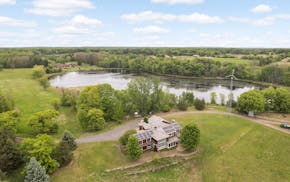A renovated Albert Lea biodiesel plant powered by wind and a carbon-offset project by a Minneapolis business that will yield thousands of carbon-absorbing trees are two recent investments that underscore Minnesota's progress in reducing greenhouse gases to combat economic and environmentally disastrous climate change.
Minnesota's growing economy also is greening. The state, for the first time according to the most recent study, is cutting carbon-based pollution as we add thousands of good-paying jobs in renewable energy and conservation technology.
Moreover, Gov. Tim Walz just signed into law a bill designed to cut carbon emissions from electrical generation by 2040, joining more than a dozen other states.
The new standard would require Minnesota utilities, with some exceptions, to phase out coal, natural gas and other fuels that generate planet-warming gases a decade earlier than Xcel Energy, Minnesota Power and Great River Energy had planned.
There will be challenges en route. And we will continue to need nuclear and natural gas-supplied juice for decades. The utilities say it will take investment and technology to clear the 2040 hurdle.
The big utilities have met timelines specified by environmental legislation since 2007. The recent legislation was denounced by some Republican legislators, concerned with cost and reliability. Residential electricity cost in Minnesota is about average for the nation. And wind and solar are now considered the cheapest generators.
State utilities have dramatically decreased carbon emissions since 2005. The biggest sector for carbon emissions now is transportation.
"The 100% carbon-free electricity bill is hugely important because it sends a signal that Minnesota is committed, creates market certainty and opens up the state to more clean energy investment," said Amelia Cerling Hennes, managing director of Clean Energy Economy Minnesota. "If the Midwest was a country, it would be among the top 10 carbon emitters in the world."
But we're improving. The Minnesota Pollution Control Agency in January reported that the state is "on track to meet greenhouse gas reduction goals for the first time" since they were adopted in 2007 by the Next Generation Energy Act.
Electrical-generation emissions declined 54% from 2005 to 2020 and transportation fell 18%. The 2020 economy-suppressing pandemic accelerated the decline. Other emissions were flat to down only 1%.
The carbon-reduction bill, in addition to recent federal legislation, includes significant incentives for the private sector to accelerate promising growth in electric vehicles and cleaner fuels and expand the renewable energy buildout.
Renewable energy provided 28% of Minnesota's electricity in 2021, according to the 2022 Minnesota Energy Factsheet released last year by Clean Energy and the Business Council for Sustainable Energy. Based on research by BloombergNEF, renewables and nuclear energy make up 52% of the state's electricity.
The state's renewable-energy industry has grown about 60,000 jobs, mostly in the past decade, from solar installers to conservation-software developers and wind technicians. That growth has been 2.5 times the rate of the overall state job market. And that doesn't include thousands of state ethanol and biodiesel jobs.
Minnesota until 20 years ago was largely an importer of fossil fuels to power its economy.
Now, outfits like the Albert Lea biodiesel plant are running on Minnesota-made wind. Chevron's Renewable Energy Group (REG), one of the nation's biggest producers of biodiesel from used-cooking and crop oils, generates more energy than it needs from the 2.4-megawatt wind turbine at the Albert Lea facility.
The turbine will save about 50,000 tons of carbon dioxide over 10 years and help REG meet aggressive carbon-reduction goals, including in California, into which REG sells biodiesel.
"Anything that you do to lower the carbon that it takes to produce your fuel adds a lot of value to your products in the marketplace, so it's a huge competitive advantage for us." Albert Lea's veteran plant manager Mike Chandler, said in a statement,
In Minneapolis, under Minnesota's first urban tree carbon offset, Winslow Capital Management in December made the first of three annual carbon-credit purchases issued by City Forest Credits through Green Minneapolis. This essentially will increase the carbon-absorbing, shade-tree canopy, funded by a company that's seeking to mitigate its carbon footprint.
Green Minneapolis, a public-private partnership, provided the Minneapolis Park and Recreation Board a total of $19,000 on the sale. Proceeds of the remaining carbon credits are projected to grow to $1.3 million over 25 years.
The state framework for further development of the clean-energy economy is flexible. It includes much grassroots input and examples, from more-efficient bio-fuels plants to increased reliance on forests and farmlands to absorb carbon and cut pollution.

How Minnesota businesses can spot and prevent invoice fraud
No place for cryptocurrency in retirement portfolios

Minnesota Department of Health rescinds health worker layoffs

Eco-friendly house on 30 acres near Marine on St. Croix listed at $1.6M
